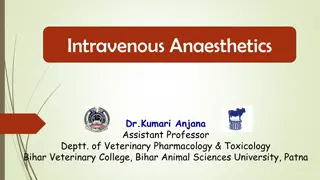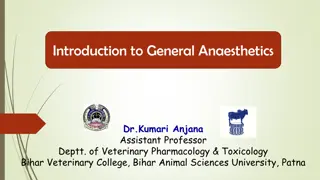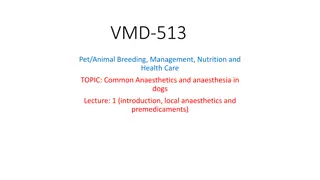Challenges Faced by Queen Elizabeth I and Medical Advancements in History
Explore the challenges encountered by Queen Elizabeth I, including issues with legitimacy, gender, and threats from abroad. Learn about the pivotal role of James Simpson in advancing medicine with the introduction of anaesthetics. Discover the intricacies of Elizabethan government and the notable tr
0 views • 11 slides
Mechanism of General Anaesthesia Theories: Lipid Solubility, Surface Tension, Microcrystal, Protein Binding
Mechanism of general anaesthesia involves theories focusing on the interaction of anaesthetics with cell membrane components like lipids and proteins. The Lipid Solubility theory emphasizes the importance of an anaesthetic's affinity and solubility in nerve cell membranes, while the Surface Tension
1 views • 10 slides
Intravenous Anaesthetics and Barbiturates: Usage, Advantages, and Disadvantages
Intravenous anaesthetics, including barbiturates and non-barbiturates, offer advantages such as easy induction and smooth recovery but come with drawbacks like lack of control over anaesthesia level and contraindications in certain conditions. Barbiturates, derived from melonyl urea, are classified
1 views • 24 slides
Understanding Inhalation Anaesthetics in Veterinary Pharmacology & Toxicology
Explore the world of inhalation anaesthetics in veterinary medicine, from the concept of MAC to the classification of gaseous and volatile agents. Learn about blood/gas and oil/gas partition coefficients, along with the properties of popular volatile anaesthetics like Ether, Halothane, and Methoxyfl
1 views • 15 slides
Understanding General Anaesthetics in Veterinary Medicine
General anaesthetics induce reversible loss of sensations and unconsciousness, crucial for effective animal surgery. The use of a combination of drugs is essential to achieve safe and rapid effects in balanced general anaesthesia. Large animals present challenges due to their anatomy, making them un
1 views • 12 slides
Common Anaesthetics and Anaesthesia in Dogs Overview
This content covers the general considerations, definitions, phases, and types of anaesthesia used in dogs. It discusses the importance of selecting appropriate drugs and techniques based on the patient's species, breed, age, health status, and procedure requirements. Key topics include local anaest
0 views • 22 slides
Overview of ACCS Training in East of England
ACCS (Acute Care Common Stem) Training in the East of England region is overseen by the ACCS Specialty Training Committee, involving Emergency Medicine, Acute Medicine, Anaesthetics, and Intensive Care Medicine. Trainees complete rotations in different specialties and are provided supervision and su
0 views • 10 slides






